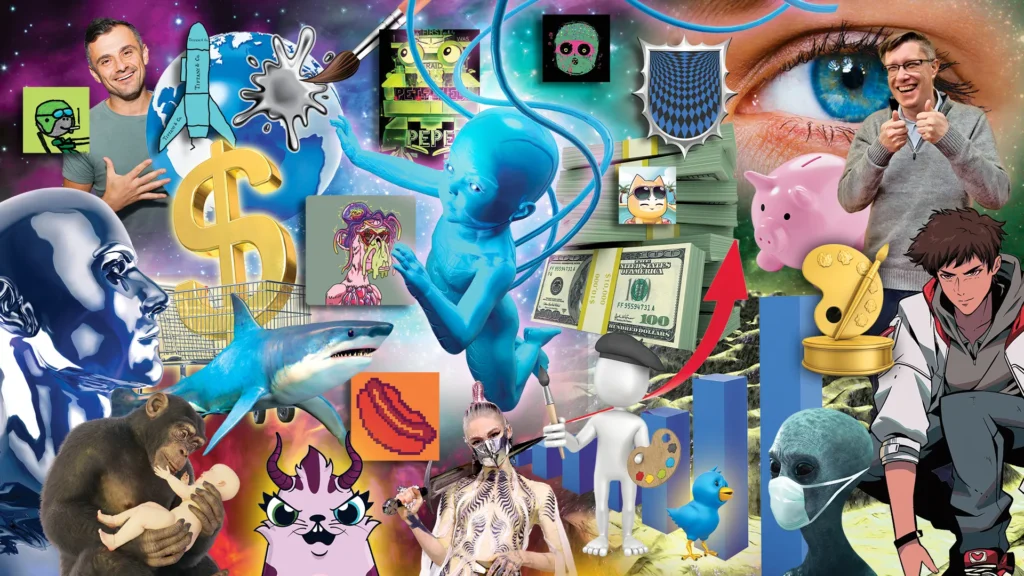In recent years, the art world has been revolutionized by the emergence of blockchain technology and Non-Fungible Tokens (NFTs). These innovations are transforming how digital art is created, owned, and sold, opening up new opportunities for artists, collectors, and investors alike. This blog explores the world of blockchain-based digital art and NFTs, highlighting how they work, their impact on the art industry, and the potential they hold for the future of creativity.
At the heart of this digital art revolution is blockchain technology, which serves as the foundation for NFTs. A blockchain is a decentralized, immutable digital ledger that records transactions across a network of computers. Each transaction, or block, is linked to the previous one, creating a secure and transparent chain of records. This technology ensures the authenticity and ownership of digital assets, a crucial element for the creation and exchange of digital art.
Non-Fungible Tokens (NFTs) are a type of digital asset created using blockchain technology. Unlike cryptocurrencies such as Bitcoin or Ethereum, which are fungible and can be exchanged on a one-to-one basis, NFTs are unique and represent ownership of a specific digital item. Each NFT contains metadata that verifies the uniqueness, provenance, and ownership of the digital art it represents. This uniqueness makes NFTs ideal for the digital art market, where authenticity and provenance are paramount.
One of the most significant impacts of NFTs on the art world is the ability to create and sell digital art in a way that was previously impossible. Traditionally, digital art was easily copied and shared, making it challenging for artists to sell their work and receive fair compensation. NFTs address this issue by providing a method for artists to create verifiable, scarce digital assets that can be bought, sold, and traded. Through platforms like OpenSea, Rarible, and Foundation, artists can mint NFTs of their digital artwork and list them for sale, reaching a global audience of collectors and enthusiasts.
For artists, NFTs offer new revenue streams and creative opportunities. Artists can not only sell their work but also earn royalties from future resales. Each time an NFT is resold on the secondary market, a percentage of the sale goes back to the original creator. This ongoing revenue stream contrasts with traditional art sales, where artists typically receive only a one-time payment. Additionally, NFTs allow artists to explore innovative forms of digital expression, including interactive art, virtual reality experiences, and algorithmically generated creations.
Collectors and investors also benefit from the rise of NFTs in the digital art world. NFTs provide a way for collectors to own and showcase unique pieces of digital art. Unlike physical art, which can be difficult to store and display, digital art can be easily shared and exhibited online. NFTs also offer investors the opportunity to speculate on the value of digital art, as the prices of NFTs can fluctuate based on demand, rarity, and the reputation of the artist. Some high-profile NFT sales have garnered significant attention, with digital artworks selling for millions of dollars, highlighting the potential for substantial returns on investment.
The popularity of NFTs has led to a surge in digital art platforms and marketplaces. These platforms provide artists with tools to mint and sell NFTs, while collectors can browse, purchase, and trade digital artworks. The rise of these platforms has democratized the art world, allowing artists from diverse backgrounds to participate in the global art market. Additionally, these platforms often feature community-driven features, such as auctions, collaborations, and artist showcases, which help build a vibrant ecosystem for digital art.
However, the NFT and blockchain art space also face several challenges and criticisms. One major concern is the environmental impact of blockchain technology. Many blockchain networks, including Ethereum, rely on energy-intensive consensus mechanisms like Proof of Work (PoW) to validate transactions and create new blocks. This process consumes a significant amount of electricity, raising environmental and sustainability concerns. However, there are ongoing efforts to develop more energy-efficient consensus mechanisms, such as Proof of Stake (PoS), and to offset the environmental impact of blockchain operations.
Another challenge is the potential for market volatility and speculation. The value of NFTs can be highly unpredictable, with prices driven by hype and speculation rather than the intrinsic value of the art itself. This volatility can lead to inflated prices and speculative bubbles, which may not reflect the true artistic merit or long-term value of the digital artwork.
Additionally, the NFT space is also grappling with issues related to intellectual property and copyright. As digital art can be easily copied and distributed, ensuring that artists retain their rights and receive fair compensation for their work is a key concern. The NFT market is still evolving, and establishing clear legal frameworks and best practices for managing intellectual property rights in the digital realm is an ongoing challenge.
The future of blockchain-based digital art and NFTs holds exciting possibilities. As technology continues to advance, we can expect to see new forms of digital art and innovative applications of NFTs. Emerging technologies like Augmented Reality (AR) and Virtual Reality (VR) offer new ways for artists to create immersive experiences, while advancements in blockchain technology may lead to more sustainable and efficient methods for managing digital assets.
Furthermore, the integration of NFTs with other digital platforms and technologies could open up new avenues for creativity and expression. For example, NFTs could be used to represent virtual items in video games, digital collectibles, or membership passes for online communities. These applications extend the concept of NFTs beyond art and offer new ways for individuals and organizations to interact with digital assets.
The blockchain-based digital art market also has the potential to expand into new regions and communities. As awareness of NFTs grows, artists and collectors from diverse backgrounds will have opportunities to participate in the global art market. This expansion could lead to a more inclusive and diverse art scene, where different voices and perspectives are represented in the digital art world.
As the world of blockchain-based digital art and NFTs continues to evolve, it is essential for artists, collectors, and investors to stay informed and engaged with the latest developments. By exploring the opportunities and addressing the challenges of this new frontier, we can collectively shape the future of digital art and contribute to the ongoing innovation in the art world.
The rise of blockchain technology and NFTs is reshaping the art industry in profound ways. Through the creation of verifiable, unique digital assets, NFTs are enabling artists to monetize their work, offering collectors new opportunities for ownership and investment, and fostering a global community for digital art.
As we look to the future, the potential for blockchain-based digital art and NFTs to drive creativity, expand access to art, and explore new forms of digital expression is immense. This technological evolution represents a new era of communication, creativity, and commerce in the art world, and its impact will continue to unfold as we advance into the future.
From Our Editorial Team
Our Editorial team comprises of over 15 highly motivated bunch of individuals, who work tirelessly to get the most sought after curated content for our subscribers.


